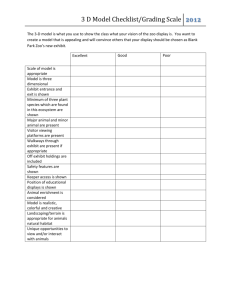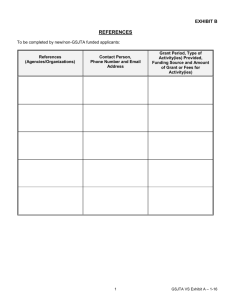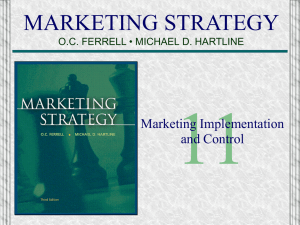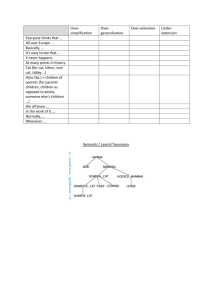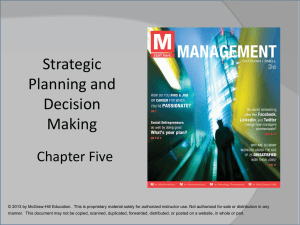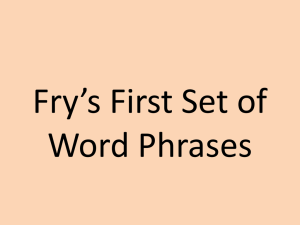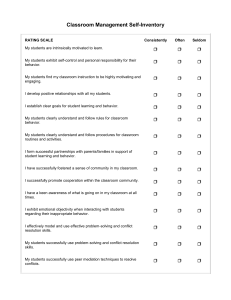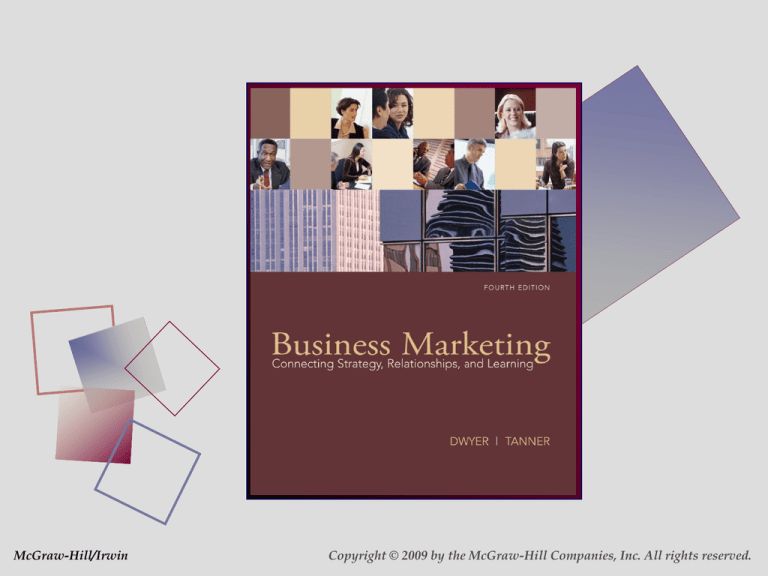
McGraw-Hill/Irwin
Copyright © 2009 by the McGraw-Hill Companies, Inc. All rights reserved.
Chapter 6
Market Strategy
ELEMENTS OF
BUSINESS STRATEGY
Determining the
product market
to serve
1
2
(What markets do we
serve with what
products)
Determine partner
relationship
commitments
3
(How do agreements
impact choices)
Determining the level
of commitment to
provide resources
4
Determining the
objectives and plans
for each functional
area
(What level of
investment in the
product market are we
willing to make)
(What are the detailed
aims and action plans)
6-3
CRITICAL ELEMENTS IN A STRATEGIC PLAN
Determining the
product market
to serve
1
2
(What markets do we
serve with what
products)
Determining the level
of commitment to
provide resources
3
Determining the
objectives and plans
for each functional
area
(What level of
investment in the
product market are we
willing to make)
(What are the detailed
aims and action plans)
6-4
STRATEGY PROCESS MODEL 1
EXTERNAL
ANALYSIS
SELF (INTERNAL
ANALYSIS
Evaluate opportunities,
threats and strategic
questions
Evaluate strengths,
weaknesses, problems,
constraints, questions
STRATEGY IDENTIFICATION
AND SELECTION
Exhibit 6-2
6-5
STRATEGY PROCESS MODEL 2
Update
historical data
Collect current
situation data
Data analysis
Develop objectives,
strategies, programs
Develop financial
documents
Negotiate final plan
Measure progress
toward objectives
Exhibit 6-2
Audit
6-6
STRATEGY PROCESS MODEL 3
1.
Track 1
2.
Develop
statement of
operating
principles and
values
Environmental scanning
3.
Define
vision
4.
Define
goals
Strategic
planning
foundation
Strategy development
5.
Define planning
6. Define total 7. Define
8. Select
assumptions &
leadership
market &
segments
implications:
requirements,
most
and define
Develop consensus re: attractive
assess long-term
corporate &
environment
strengths &
segments
segment
(customer/market,
weaknesses in
strategy
competition,
attractive segments
suppliers, etc.)
Strategy integration and capability development
Gap analysis
9.
Define capability
10.
gaps by assessing
strengths/
weaknesses against
current capabilities &
specific competitors in
selected segments
Track 2
Track 3
Define
mission
Formulate 11.
strategies that
yield
competitive
advantage
Exhibit
Appraise, test 12. Modify
& reconcile
goals if
strategy with
required, set
functional
functional
plans/
and
needs
business
objectives
6-2
Business
strategy
Strategy
integration
capability
development
6-7
WANTS-GETS GRID
HIGH PERFORMANCE
Assistance
in cost control
OVERACHIEVEMENT
Reliable
delivery
Consistent product
quality and
appearance
Sales
support
UNDERACHIEVEMENT
Fast order
cycle
Access to top
management
Lead
generation
HIGH IMPORTANCE
Exhibit 6-5
6-8
CONCEPTUAL MAP
Project manager’s
competency
Hi
NOVUS
MAVUUS
T3
Reputation
for
Good Excellence
Bad
CLARKE
Lo
Exhibit 6-6
6-9
VALUE CHAIN ANALYSIS
Share of user $
Manufacturers
100
Specialty
Wholesalers
120
Manufacturers
Distributors
1
Dealers
Users
2000
2005
150
300
40%
50%
Users
60%
50%
100%
100%
Total spending by users $10mm
$15mm
2
101
130
200
Exhibit 6-7
6-10
FIVE FORCES OF COMPETITION
Threat of
substitutes
Bargaining
power of
suppliers
Struggles
between
industry rivals
Bargaining
power of
customers
Threat of
potential
entrants
Exhibit 6-8
6-11
BARRIERS TO ENTERING A
MARKET
•
•
•
•
•
•
PRODUCT DIFFERENTIATION
ECONOMIES OF SCALE
CAPITAL REQUIREMENTS
ACCESS TO DISTRIBUTION CHANNELS
COST DISADVANTAGES UNRELATED TO
SIZE
GOVERNMENT POLICY
Exhibit 6-9
6-12
ACTIONS TO MEET COMPETITIVE
CHALLENGES
•
•
•
CHOOSE ITS COMPETITIVE
BATTLEGROUND JUDICIOUSLY
CHANGE THE COMPETITIVE
STRUCTURE OF THE INDUSTRY
ANTICIPATE AND EMPLOY CHANGE
6-13
Vision for disruption
Identifying and creating opportunities for temporary advantage
through understanding
•Stakeholder satisfaction
•Strategic soothsaying
Directed at identifying new ways
to serve existing customers
better or new customers
that no one else
serves now
Capability
for disruption
Sustaining the momentum by
developing flexible capacities for:
Market
disruption
• Speed
• Surprise
that can be applied across
many actions to build a
series of temporary
advantageous
Tactics
for disruption
Seizing initiative to gain
advantage by
•Shifting the rules
•Signaling
•Simultaneous & sequential
strategic thrusts
with actions that shape, mold,
or influence the direction on
nature of the competitors’
responses
Exhibit 6-10
6-14
KOMATSUV CATERPILLAR
Arena 1
Cost & Quality
Arena 2
Timing & Know-how
Disrupt Cat’s strategic strengths
Boost
Lower
quality cost
Timing
Rolls out
one
product
at a time
Know-how
Aggressive
R&D and
new product
program
Erodes Cat’s
premium price,
global volume,
low costs
Picks off
Cat’s full
line one
by one
Undermines
Cat’s
advantage
on product
innovation
Arena 3
Strongholds
Arena 4
Deep Pockets
Outmaneuver Cat’s strengths (“Encircle” Cat)
Geographic
Komatsu moves
out of Japanese
stronghold to
Asia, Europe,
South America,
and lastly
North America
Erodes
Cat’s World
dominance
one place
at a time
Channels
Komatsu
moves to
direct sales,
dealers, then
regional
centers
Maneuvers
around
Cat’s strong
dealer
network
Komatsu
builds
resources,
new plants
and user
alliances to
Gain
strengths
initially
Erodes
Cat’s deep
pockets
From the Field: 6-1
6-15
MARKET ORIENTATION ELEMENTS
BEING SYSTEMATIC IN:
1. Gathering of information on customers and
competitors
2. Analyzing information to develop market
knowledge
3. Using this knowledge to guide strategy
6-16
PAYOFFS FROM A MARKET
ORIENTATION
A MARKET ORIENTATION COMPANY IS:
1. BETTER AT FITTING NEEDS OF
CUSTOMERS
2. MORE DIFFICULT FOR COMPETITORS TO
ASSESS
3. APT TO BE UNIQUE
6-17
REQUISITES FOR THE LEARNING
ORGANIZATION
Visionary
leadership
x
Target &
trajectory
x
Information
systems
x
Creating
&
striving
x
Execution
Exhibit 6-13
6-18

